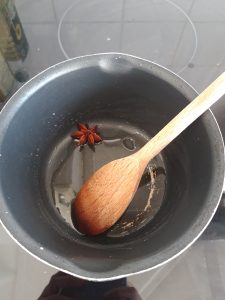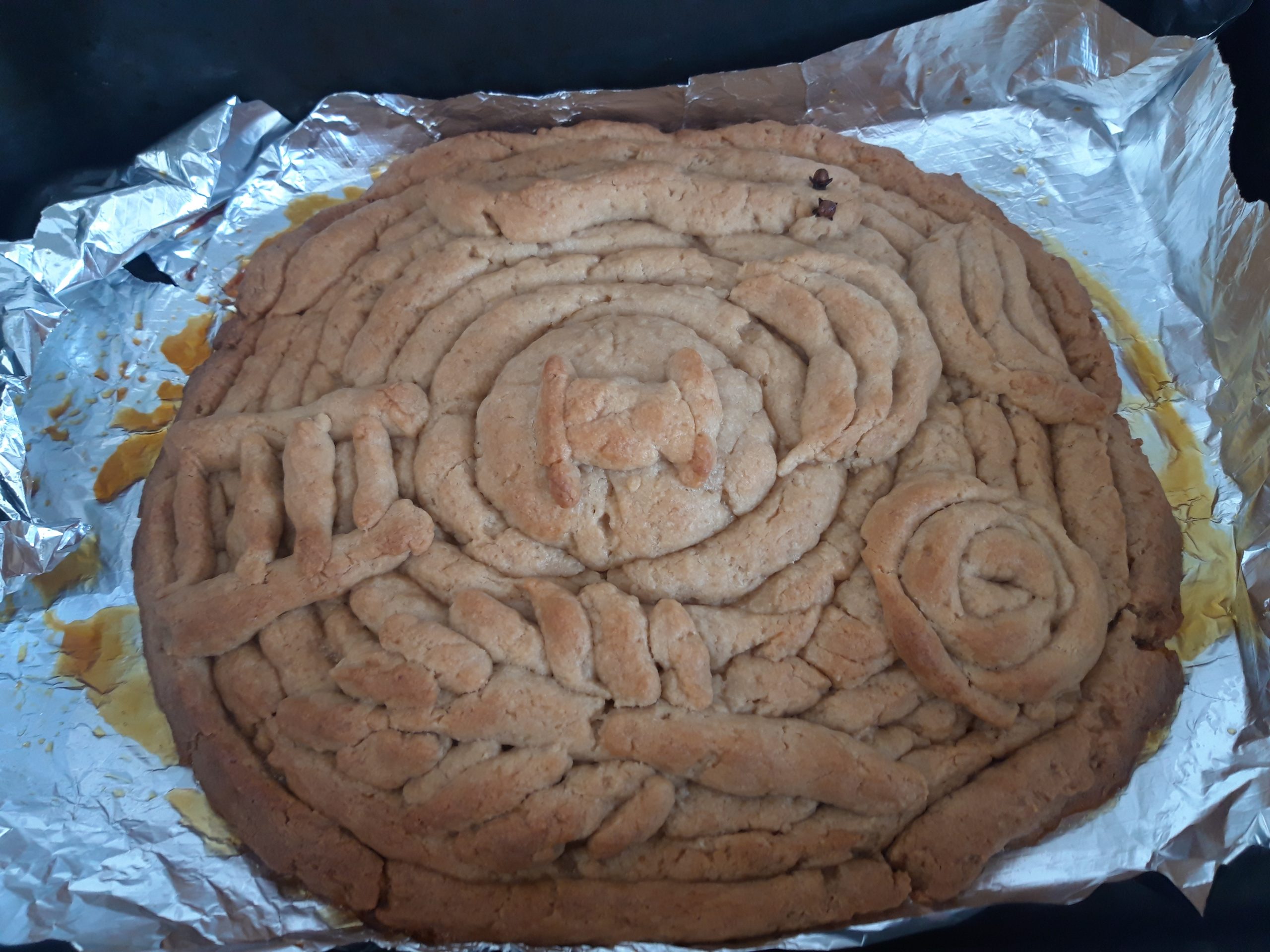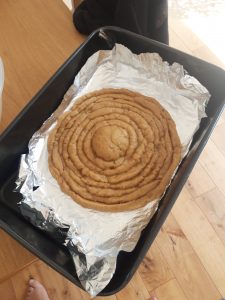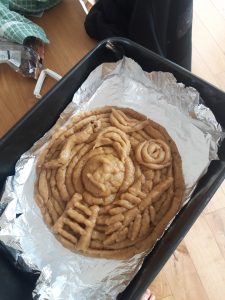There’s a famous Talmudic saying:
אֵין קֶמַח, אֵין תּוֹרָה
Ein kemach, ein torah
If there’s no flour, there’s no Torah.
– Pirkei Avot 3:17
In other words, how can we even begin feeding our minds, if we haven’t yet fed our bodies? I’ve known this saying for a while, but what I didn’t learn until recently was that there is actually a recipe that will allow you to digest both flour and Torah at the same time!
One of the best things about being a Kohenet (Hebrew Priestess) is being connected to a sisterhood/siblinghood of women who are keen to reclaim lost folk traditions from around the world. A few weeks ago, somebody shared this article about a Greek-Sephardic bread made especially for Shavuot. On Shavuot, we celebrate the wheat harvest and G-d/dess’s gift of Torah to the Jewish people. The Jews of Salonika used to bake el pan de siete cielos – the bread of the seven heavens – as part of their Shavuot celebrations. This was a custom for nearly 800 years, from the arrival of Sephardic Jewry to Salonika in 1492 to the decimation of the Salonikan Jewish community by the Nazis. Sadly, very few Salonikan Jews survived the Holocaust, so, with them, the memory of this practice has nearly died out. However, as the article reports, a version of the recipe survived thanks to Nicholas Starvroulakis, who interviewed Salonikan Holocaust survivors for his Cookbook of the Jews of Greece.
So, what makes el pan de siete cielos special, other than that the recipe has very nearly been lost from human memory? It’s a rich bread, fattened up with milk, butter, sugar, and eggs, and flavoured with anise extract or arak. Sephardic Jews were inspired by the beautifully-shaped sweet Easter breads of their Christian neighbours, and they wanted to join in the fun. However, instead of shaping their bread into Jesus’s crown of thorns or symbols of resurrection, they sculpted it into symbols of Shavuot. Traditional shapes included some or all of the following:
- Mount Sinai
- The Torah
- 7 rungs of clouds, to represent the seven levels of heaven (hence, “the bread of the seven heavens”)
- Miriam’s Well
- Jacob’s Ladder
- A snake (because of the plague of snakes suffered by the Israelites in the wilderness, Numbers 21:6)
After learning about el pan de siete cielos, my first feeling was a sense of loss – what a beautiful custom, one of many beautiful customs, lost and destroyed, along with her people! But then, I decided that I wanted to be a part of ensuring that the memory of the Jews of Salonika would not be lost, and participate in the revival of this delicious practice. Only two things stood in my way: veganism and lockdown.
However, I (and my trusty assistant/partner) were not to be deterred! After several unsuccessful epic searches for flour from empty-shelved supermarkets, my partner finally returned home with two sacks of all purpose flour. Anise extract or arak, however, were not to be found. I decided to make my own substitute, using whiskey, star anise, water and agave nectar. In place of eggs, I used vegetable oil; for butter, vegan spread; for milk, soy milk. I halved the original recipe – while I feel incredibly lucky to have everything I need right now, after the epic search for flour, it didn’t seem wise to use it all up in one go and there’s other folks out there who need flour, too.
Shaping el pan de siete cielos was definitely the most fun part of the endeavour. I included all the traditional shapes, even adding cloves to give the snake eyes. I had some dough left over, so I decided to add some more symbols that seemed appropriate: a sheaf of wheat, representing the wheat harvest at Shavuot, as well as Ruth, the heroine whose story we read on Shavuot, who gleans wheat in the fields; and the Wings of Shekhinah, the divine feminine presence, who is sometimes envisioned as having wings.
Then, the moment of truth: the bread needed to go into the oven. What emerged was a delightful, golden-edible sculpture, somewhere between a biscuit, a cake and a loaf of bread. My partner’s review was the following: “It’s sweet, it’s carby, it’s oily – what’s not to like?”
If you want to have a go at making your own pan de siete cielos, here’s my vegan, lockdown-friendly version, inspired by the one collected by Nicholas Starvroulakis:
(You can also view the step-by-step recipe here.)
Ingredients:
For the “anise extract” (no need to do this if you can actually find anise extract, arak or pastis):
- 1 tbsp water
- 1 tbsp whiskey (or whatever strong alcohol you can find – vodka would probably work well, too)
- 1 star anise
- 1 tbsp agave (or whatever liquid sweetener you can find – maple syrup would work well, or you could make some sugar water)
For the dough:
- 4 cups flour
- 1 cup sugar
- .5 oz dry yeast (approx 2.5 tsp)
- ⅝ cup veg oil
- ⅙ cup warm water
- 2.5 tbsp vegan butter
- ½ tsp anise extract (can be made using the above recipe or bought; arak, pastis or similar anise-flavoured alcohols can be used instead, as well)
- ¼ cup soy milk (or whatever vegan milk you prefer or can find)
- (optional) 2 whole cloves (or something else that can be used to make the snake’s eyes – seeds, for example)
For the glaze:
- 1 tbsp agave (maple syrup works, too)
- 1 tbsp water
Directions:

- First, make the “anise extract.” Put the water, whisky, star anise and agave into a small saucepan. Cook it on medium-low heat for approximately 20 minutes, stirring occasionally. Remove it from the heat to allow it to cool. Keep the star anise inside, so it can continue to emit flavours.
- Then, it’s time for the dough! Dissolve ¼ teaspoon of sugar in the warm water. Mix in the yeast, and allow to rest for 15 minutes.
- Add the flour and mix well. Cover the bowl with a clean towel and allow the dough to rise for 30 minutes.
- Whisk together the sugar, the “anise extract,” and the oil.
- Melt the vegan butter on low heat. If you still have your star anise, you can add it to the vegan butter to soak out the remains of the anise flavour.
- Add the sugar and “anise extract” mixture, vegan butter and soymilk into the dough. Knead well.
- Cover the bowl with a towel and allow to double in size.
- Now, it’s time to shape your bread! But first, go ahead and preheat your oven to 200 degrees celsius and line your baking tray with parchment paper or aluminium foil. Once you’ve done that, it’s go time:

Mount Sinai surrounded by the 7 Heavens - Start with a ball of dough in the centre – that’s Mount Sinai.
- Shape 7 ropes of dough, each one slightly longer than the last. Wrap them one at a time around Mount Sinai – these are the clouds, the seven heavens.
- Shape the Torah on top of Sinai – two miniature rolls for the atzei chayim (the Trees of Life – that’s what the wooden handles are called) and a small rectangle for the scroll.
- Make Miriam’s Well – this one is a few small concentric circles.
- The snake is a rope of bread, curved about. If you like, you can give it eyes made of cloves or something else, like seeds
- Then, Jacob’s ladder. This can be made by laying two longer ropes of bread and then shorter ones to be the rungs.
- If you have any extra dough left, feel free to add other shapes that speak to you! Here are my renditions of a sheaf of wheat, in honour of Ruth and the harvest, as well as the Wings of Shekhinah. Other shapes that could be fun for Shavuot, connecting to Shavuot’s themes of Divine Revelation and Prophecy (that is, receiving messages from G-d/dess): the Burning Bush, Balaam’s talking donkey, or a palm tree for Deborah the Prophetess. Feel free to be creative.
-

Fully-shaped pan de siete cielos Once you’re happy with your shapes, make the glaze by mixing together the agave and water. Brush your bread with the glaze delicately, so as not to disturb your artwork.
- Bake for 10 minutes at 200 degrees celsius. Then, lower the temperature to 175 degrees celsius. Bake for an additional 20 minutes, or until the bread is golden brown on top.
- Allow to cool just enough so that you won’t burn your mouth on it. Remember to take a picture for posterity – you’re about to eat a work of art!
- Enjoy.
Chag sameach.
 Kohenet Yael Tischler is a ritual-weaver, Jewish educator and song leader. She is the co-founder of Yelala, a constellation of work that celebrates Earth-centred, feminist Jewish spirituality and reclaims the practices of our women/femme and folk ancestors. She holds an MA in Writing for Young People from Bath Spa University, a BA in English Literature from Columbia University and a BA in Tanakh (Bible) from the Jewish Theological Seminary.
Kohenet Yael Tischler is a ritual-weaver, Jewish educator and song leader. She is the co-founder of Yelala, a constellation of work that celebrates Earth-centred, feminist Jewish spirituality and reclaims the practices of our women/femme and folk ancestors. She holds an MA in Writing for Young People from Bath Spa University, a BA in English Literature from Columbia University and a BA in Tanakh (Bible) from the Jewish Theological Seminary.






















